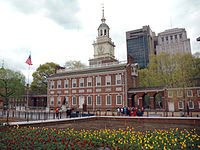
Back المستعمرات المتحدة Arabic Birləşmiş Koloniyalar Azerbaijani המושבות המאוחדות HE Colonie Unite Italian
United Colonies of North-America (1775–1776) United Colonies (1776) United States of America (1776–1781) | |||||||||
|---|---|---|---|---|---|---|---|---|---|
 Thirteen Colonies of North America: Dark red = New England colonies. Bright red = Middle Atlantic colonies. Red-brown = Southern colonies. | |||||||||
| Status | Unrecognized state | ||||||||
| Capital | Philadelphia (de facto) | ||||||||
| Common languages | English | ||||||||
| Government | Revolutionary confederation | ||||||||
| President of the Continental Congress | |||||||||
• 1775 | Peyton Randolph (first) | ||||||||
• 1779-1781 | Samuel Huntington (last) | ||||||||
| Legislature | Continental Congress | ||||||||
| Historical era | American Revolutionary War | ||||||||
| May 10, 1775 | |||||||||
| July 2, 1776 | |||||||||
| July 4, 1776 | |||||||||
| Currency | Continental currency | ||||||||
| |||||||||
| This article is part of a series on the |
| United States Continental Congress |
|---|
 |
| Predecessors |
| First Continental Congress |
| Second Continental Congress |
| Congress of the Confederation |
| Members |
| Related |
|
|
The United Colonies of North-America[1][2] was the official name as used by the Second Continental Congress in Philadelphia for the newly formed proto-state comprising the Thirteen Colonies in 1775 and 1776, before and as independence was declared. Continental currency banknotes displayed the name 'The United Colonies' from May 1775 until February 1777, and the name was being used to refer to the colonies as a whole before the Second Congress met.
- ^ Aitken, R. (1777). "I". Journals of Congress. Philadelphia. pp. 143–8.
A Declaration by the Reprensentatives of the United Colonies of North-America, now met in Congress at Philadelphia, setting forth the Causes and Necessity of their taking up Arms.
- ^ Reprensentatives of the United Colonies of North-America (July 6, 1775). "A Declaration by the Reprensentatives of the United Colonies of North-America, now met in Congress at Philadelphia, setting forth the Causes and Necessity of their taking up Arms". Philadelphia. Archived from the original on November 25, 2018.
A Declaration by the Reprensentatives of the United Colonies of North-America, now met in Congress at Philadelphia, setting forth the Causes and Necessity of their taking up Arms.

